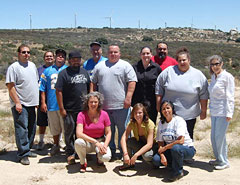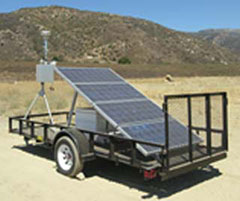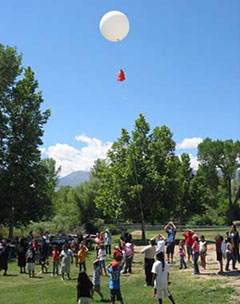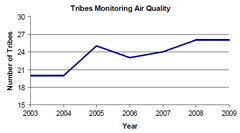Pacific Southwest, Region 9
Serving: Arizona, California, Hawaii, Nevada, Pacific Islands, 148 Tribes
Tribal Accomplishments, 2009
Clean Air



History of R9 Tribal Air Program
The Navajo Nation received the first Region 9 tribal air grant in 1985 to develop their program’s capacity to work with the many major air pollution sources (including two large coal-fired power plants) on their reservation. In 1994, EPA began to allocate air grant funds targeted exclusively for tribes, and in 1998, EPA finalized the Tribal Authority Rule, which gives tribes authority to develop and implement their own Clean Air Act (CAA) programs. To date, seven tribes in the Pacific Southwest Region have received EPA approval to implement parts of the CAA.
Since then, EPA Region 9 has worked hard to increase the number of tribes receiving CAA funding. Today there are 30 tribal governments carrying out air grant activities, including monitoring, regulatory development, indoor air, and education tasks under their grants. Two recent successes are the Navajo Nation taking delegation of the federal air permit program in 2004, and the Gila River Indian Community submitting a full Tribal Implementation Plan (similar to the regulatory plan each state has with EPA) in 2007.
Tribes in Region 9 are currently engaged in regional air planning, and participating in EPA’s process for setting air standards and designations. They are equal partners with EPA in protecting human health and the environment in Indian Country.
Tribal Air Funding for 2009
To improve air quality in Indian Country, EPA provides funding for tribes to identify air pollution problems. In 2009, EPA awarded 30 tribal air grants for a total of more than $3 million. In addition, EPA awarded a radon grant to the Navajo Nation.
Tribe Collaboration
EPA continues to encourage collaboration between tribes. Many tribes are sharing air quality information, training resources, and consultant time. An impressive example of this type of cooperation is the group of tribes in southeastern San Diego County. They call themselves “The Air-heads” and meet once a month to discuss the progress of their air programs.
Tribal Air Monitoring
With EPA funding, 26 tribes are currently monitoring for either particulate matter (PM), ozone, or air toxics. Tribes are also working to enter their monitoring data into EPA’s national Air Quality System (AQS). Eighteen tribes are now successfully submitting data – two more than the previous year. Because these tribes are submitting data, EPA has a better understanding of air quality in Indian Country. EPA uses this data to set national air standards, and to determine whether states and tribes meet those standards.
New Standards for National Ambient Air Standards
In 2008, EPA set a more stringent national standard for fine particulate matter (PM2.5) – particles that are smaller than the width of a human hair. The Agency anticipates that a number of tribes will be in areas that do not meet the new standard. Where this occurs, the state or local agency will be required to develop a plan to meet the standard. Affected tribes can participate in the planning process.
Also in 2008, EPA set a new, more stringent national standard for ozone at 0.075 parts per million (the previous level was 0.08 ppm). The new level is lower to better protect human health. Six tribes (Bishop Paiute Tribe, Gila River Indian Community, La Jolla Band, Morongo Band, Salt River Pima-Maricopa Indian Community, and Tohono O’odham Nation) submitted recommendations to EPA stating whether they believe their area meets the standard. In 2010, EPA will publish a final determination on which areas meet the new ozone standard, and which do not.
In June 2009, EPA proposed a new one-hour standard for Nitrogen Dioxide (N02). The public comment period ended in September 2009. EPA is now reviewing the comments received and will make a final decision on the revised standard by the end of 2009.
EPA also finalized a more stringent standard for lead (Pb) in 2008. The Agency is requesting recommendations from states and tribes on attainment and nonattainment areas, and will increase lead monitoring in 2010.
Tribal Regulatory Development
As tribal air programs mature, some tribes are working on regulatory development. EPA continues to work with the Gila River Indian Community on the tribe’s eligibility determination for the Tribal Implementation Plan (TIP) under the Clean Air Act (CAA). The TIP will allow the tribe’s regulatory program to be federally enforceable and will delegate many of EPA’s air programs to the tribe.
Permitting Issues
In 2009, the court upheld EPA’s position in a Navajo Nation case about the Federal Implementation Plan (FIP) for the Four Corners power plant, issued in May 2007. The court upheld EPA in all respects, and affirmed that EPA can work with tribes on targeted FIPs to fill regulatory gaps.
Navajo Best Available Retrofit Technology (BART) Federal Implementation Plan
Also in 2009, EPA issued an Advanced Notice of Proposed Rulemaking (ANPRM) concerning anticipated visibility improvement and cost effectiveness of controls to meet the BART requirement of the Regional Haze Rule (RHR) for two coal-fired power plants, the Four Corners Power Plant and Navajo Generating Station, both located on the Navajo Nation. The Navajo Nation EPA requested U.S. EPA to promulgate FIPs specifically for the BART provisions of the RHR to reduce NOx and PM to improve visibility.
Environmental Youth Education
Tribes’ environmental outreach in the Pacific Southwest Region takes many forms, from Earth Day community events, to presentations in schools. The Bishop Paiute Tribe and the Lone Pine Paiute-Shoshone Tribe collaborated with the Las Vegas National Weather Service Office to produce a “Kids Weather Day” event, demonstrating that the dramatic eastern Sierra Nevada Mountains weather captures young imaginations.
Protecting Tribal Lands
Tribes and EPA share the goals of protecting human health and the environment. As tribal air programs mature, tribes are using their knowledge to monitor air quality on reservations, deploy technology that harnesses wind and solar energy, educate their communities, and participate in regional air quality groups.
| Pacific Southwest NewsroomPacific Southwest Programs | Grants & FundingUS-Mexico Border | Media Center Careers | About EPA Region 9 (Pacific Southwest)A-Z Index |

